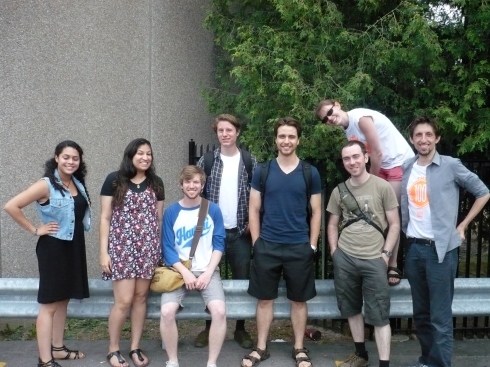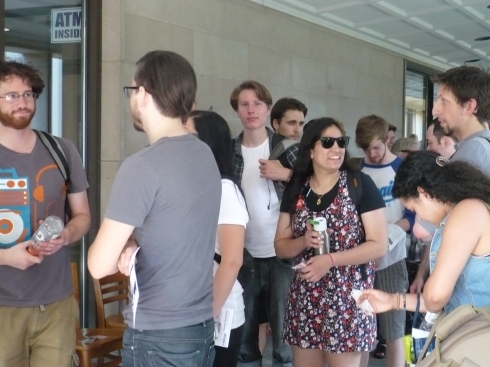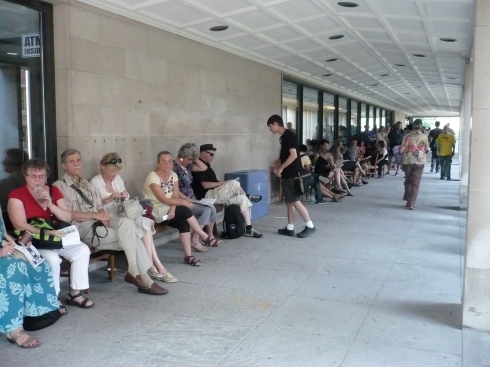
After the show, here we are. Thank you so much to everyone in the Fringe 2012 program! It was an absolute blast.
More reviews will be posted soon. For now, enjoy the photos!

After the show, here we are. Thank you so much to everyone in the Fringe 2012 program! It was an absolute blast.
More reviews will be posted soon. For now, enjoy the photos!

Getting excited! The line will move now!
The show has been completely sold out for most of Fringe.

This is the line-up for Help Yourself, winner of the Best New Play Award at Fringe 2012.
The Book of Reviewing
For Intermission
What is a review?
A review is an opinion-based piece about a performance (or presentation, book, concert, etc). A review is written to provide information about the merits of the performance to those who have not yet seen the performance.
A review often contains partial summaries, teasers, and pointers about which parts were excellent and which were mediocre. It doesn’t spoil the ending, and avoids discussing parts of the show that would give away the surprise.
A response, by contrast, is written for people who have already seen the show. It is meant to encourage discussion, and may contain spoilers as the readers of the response will have already seen the show.
Megan Mooneys DOs and DON’Ts of Review Writing
MEGAN MOONEY IS VERY AMAZING. Thank you so much, Mooney on Theatre!
1) DO be personal.
a. A show can never be good or bad, but people can have very different opinions about it.
b. Therefore, talk about why you liked it (or didn’t), and how this or that scene made you feel.
c. Tell us about you experiences with similar plays in the past. Tell us why the topic at hand means something to you. Tell us why you wanted to see the play in the first place (or didn’t want to).
d. These all help explain your perspective, which helps the reader understand why you did or did not like aspects of the play. It helps the reader know if they would have the same opinion as you, and a similar reaction to the show.
e. This is the most important DO! It makes your review interesting!
2) DON’T be vague. DO be specific.
a. If you liked something, tell us exactly what it was!
b. If you hated something, tell us exactly what did not work for you.
c. The more specific you can be (even if that means you have a really long list of things to talk about) the more people can relate to your review, or response.
d. This won’t always be easy. And specifics can be hard to remember. But this is how you analyze, and how you will get better at discussing theatre and other things.
e. In addition, being specific is also great for the people who saw the show. If they read your review, they’ll want to know what it was that “sucked”! It helps them become better performers and artists if you are specific.
3) DON’T give away the surprises.
a. This can be really hard if you liked a play or it blew your mind.
b. But don’t give it away.
c. If it’s really, really too hard not to mention the end – say that you are having trouble! Say that it’s really hard not to break the surprise! It’s probably a good reason to see the show.
4) DON’T worry about making it for every person on the planet. DON’T even worry about making it for every person in Toronto.
a. Your review can’t be a universal explanation of everything.
b. It may not help every single person who reads it.
c. But if you are personal, and if you include details, most people will find it more helpful than if you talked about how the meaning of life is embodied in this play.
d. By NOT generalizing, you actually make it easier for people to understand, and to make decisions.
Questions to consider
Aka. Prompts for your memory, and ideas to think about.
1) What did you leave the theatre thinking about?
2) Do you remember most of all from the show, now? How much is that related to what you think the “message” or “theme” of the show was? Why do you remember this/these things?
3) What did you connect with, or identify with – or with whom? On the other hand, did anything repel you, gross you out, make you angry, etc? What and why?
4) Were you ever bored? Did you ever look at your watch, or start looking at the audience? What were you thinking at the time? What was happening on stage – or what scene were they in, what was happening plot-wise? Was this a bad boredom, did it detract from the show? Why?
5) Think about the set, the costumes, the light changes (or the lack thereof!). Can you see choices about the design that helped the play, or hindered it?
a. For example, were there symbolic set pieces, or props? Were the costumes realistic, or over-the-top, or symbolic themselves?
b. Did you feel that all the choices fit together, the way a well composed painting or photograph does? Did it help you draw connections about the story or the issues in the play?
6) Did you feel that the play was “finished”, when it was over? Did you have a mental click where everything fit into place? Did you feel that things were unfinished?
a. Did you have lingering questions that you wish were talked about or answered? For example, something in the plot that was forgotten about, or a character that never came back and was unexplained. Or themes and ideas that they raised, and seemed to say “this is really important!” but then make no comment on the issue other than it’s “important”, etc.
b. How would you like the play to continue? Do you think it was great the way it ended? (for dramatic reasons, for characters, for leaving a good question in the air, etc)
7) If you’re still reading, feel free to add your own questions! These are just starters and prompts to help you remember everything!
What to do if you’re stuck
1) Start writing something down.
a. Start writing down what happened in the play. Make a summary.
b. Describe the characters.
c. Now you can start thinking about the writing style, how the words sounded, how the characters had details about their lives, how the plot worked, etc.
2) Write for as much as you like. You can edit afterwards.
a. But if you need a specification, write one and a half – two double spaced pages.
b. For comics, probably about the same length. For drawings, one or two pages. You get the idea. The most important thing is connections and creativity.
3) Draw a map of connections.
a. Each character can be a node – connect them and write how each connection works (how are they related, what happened, etc).
b. Each issue can be a node.
c. Each piece of the set can be a node.
d. Costumes can be a node.
e. Connect these nodes to each other and think about the ways in which they interact.
4) Don’t think about making it perfect. Don’t think about the whole thing. Just start writing about your favourite or least favourite part – the thing that got you the most fired up.
5) Are you trying to make EVERYONE like it? Stop that. Write so that the folks in Intermission can learn something about the show and what you thought about it. Write for your best friend who hasn’t seen it yet.
Hi everyone,
I am pleased to announce that we are running a summer program with the Toronto Fringe Festival!
Over the course of two weeks, participants get to see 5 shows free, meet with the actors and creative teams of the shows, participate in the Tent Talks at Fringe with some of Toronto’s leading arts workers, and have a workshop on writing theatrical reviews with one of Toronto’s amazing theatre critics!
You will be traveling the Fringe in a group of 4. Just before Fringe, we will be having a pizza party, during which you’ll meet your group, and as a group, select the shows you want to see. You will be able to pick the shows yourself, meaning you can coordinate with your group how your program will run!
Intermission will provide you tickets and materials. It will be an awesome summertime blast!
Fringe runs July 4th-15th. Our pizza party will be July 2nd, Canada Day (don’t worry, we won’t less you miss the fireworks).
The sign up deadline is midnight on June 15th, 2012. You must be between 16 and 20 years of age. Send your name, age, and a paragraph on why you think seeing 5 consecutive shows in two weeks would be fantastic, and what you could contribute to your group. Please send applications to intermission.toronto@gmail.com
It is that time. Our fall program is very fast approaching, and we are still able to take more participants!
Are you ready to “audition”? Relax, as there is no audition required! We are not only for performers. Send us an email with your name and age, contact info, what community centre you are associated with, and a brief statement saying why you would like to take part in our program and what about theatre interests you. That’s it! It’s very easy!
Email those notes to intermission.toronto@gmail.com, and that’s all it takes. We will get back to you very quickly.
Our program starts on September 8th, spread the word!
Also – a note about our brochures. If you have a brochure, you may notice it says we are meeting on Wednesdays. That is a typo! Our sincerest apologies for any confusion. We meet on Thursdays!
We look forward to meeting you!
Thank you to everyone who came to Youth Night! There were some excellent performances, and a great deal of fun with fight choreography. Here are a few pictures of the group! Photographs are all copyright Jennifer Xu of Sunshine In Toronto. Thank you so much for taking pictures!
This Friday is Intermission’s first event! We are going to be at Canadian Stage’s Dream in High Park Youth Night!
Dream in High Park is an annual event (this year is the 29th edition) produced by Canadian Stage. It takes place at the beautiful High Park amphitheatre, and is an extraordinary performance of outdoor Shakespearian art. This year’s production is A Winter’s Tale.
Youth Night emerged to welcome Toronto’s youth to the outdoor Shakespeare world. Complete with workshops, backstage tours, talkbacks, visual art, music, dance and more, it is a phenomenal way to meet other artistically minded youth, and to experience theatre.
I’m personally very excited to meet so many youth, artists and community groups. And I’m excited about our buttons. Intermission volunteers are going to be wandering the crowds during the workshops and pre-show performances clinking with the buttons on our shirts. Want a button? Just ask! They are very colourful.
The other big reason to be excited is the main attraction: A Winter’s Tale. The past several years have seen a bunch of different renditions of A Midsummer Night’s Dream, and traditionally at the Dream in High Park, the play choice has been comedy, with the addition of Romeo and Juliet. While Midsummer is the obvious and excellent choice for the outdoors, it’s a pity that tragedies get the brush. Romeo and Juliet is even easily seen has half comedy – it’s all giggles and adoration until Mercutio hits the deck with a stab wound. A Winter’s Tale is not a tragedy. It’s really quite hard to classify. The first half is anguish and the displeasure of the king, and the second half turns into a love story adventure and family reunions. As with several of Shakespeare’s plays, a small device, that is almost unbelievable in its speed and action, has incredible consequences that form the rest of the play. At the end of this play, we receive a happy ending, forgiveness and love.
A slightly less academic reason to see the play is it is one of the literary origins of the name “Hermione”, as well as the classic stage direction “Exit: pursued by a bear”. You’ve got to want to see a bear. I mean, really. It’s a bear. Eating someone.
But on the whole, producing A Winter’s Tale is more interesting and engaging for me, because it diverges from the traditional outdoor comedy. Just because we can feel the sunset on our necks as the stage lights take over, and smell the grass and the remains of the pizza dinner, and the birds (and hopefully not the crowds) twittering overhead – it does not mean that comedy is the only thing that will keep an audience focused.
A few years ago, I was in an outdoor production of Henry V, a perfect example of a non-comedy (a history) that is suited to the outdoors. The battlefields, the traveling, the campfires…all this is more readily experienced by the audience in a park than in a theatre. I await the day that they do Macbeth and recreate the moors of Scotland on the grassy hills of High Park. After all, the outdoors are chilling as well as playful.
Fortunately, the weather report has begun to shine on us; it will now rain itself out in time to be cheerful on Friday. We have spent the past week or so preparing some materials to help spread the word. Brochures and Buttons are at the ready. The fabulous Lauren has created a logo for us. Check out the preview of the logo below on our current button: